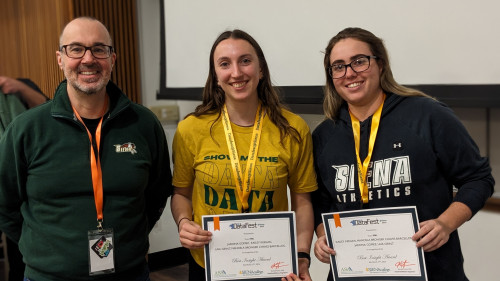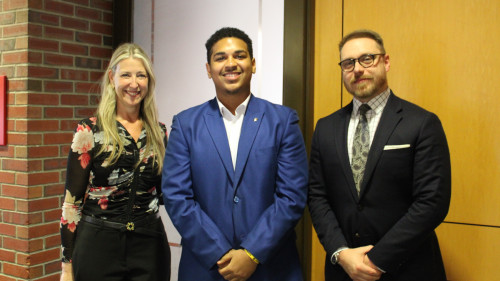
A porcupine lumbers through the brush, looking like an uninspired employee headed for the start of his shift. A hungry fox slinks about, looking for a tasty dinner of mouse or chipmunk. Curious deer stare right into the…camera lens?
These wildlife sightings and others are captured each fall by Dan Bogan, Ph.D., associate professor of environmental studies and sciences, and his students. As part of their work with Snapshot USA, they strategically place camouflaged cameras throughout the Pine Bush Preserve in Albany and the Dyken Pond Environmental Education Center in Rensselaer County to photograph whatever goes flying, wandering or hopping by.
This is the fifth year Bogan’s Environmental Science class has taken part in this project. The cameras – 15 at each site, 200 meters apart – use motion and heat detectors to sense when an animal is nearby. After the students collect the cameras that have been clicking away throughout September and October, Bogan then uploads up to 40,000 resulting photos to Snapshot, which uses artificial intelligence to identify the animals and track patterns in their behavior.
“The photos are a way to document mammals in a systematic way to make comparisons of their distribution across the U.S.,” said Bogan. “By monitoring this information, we can look for population changes across wildland, suburban and urban areas, and across differing biomes such as deciduous forests, prairies or deserts.”
Snapshot USA was created in 2019 by the professor who served as Bogan’s graduate school advisor. It now collects photos from about 100 researchers across the United States; a Snapshot Europe was recently launched. He said it helps track how humans are impacting landscapes and wildlife populations.
“Animals can change their behaviors in response to the presence or absence of humans,” he explained. “It was especially interesting to observe before, during and after the pandemic, as more and more people used the natural environment for freedom and recreation.”
He said the cameras do not disturb the animals, but they can sense something is there. Shutter speeds are so quick they can capture birds in mid-flight or mid-divebomb.
"Participating in the Snapshot USA project proved to be an enriching educational experience. A notable highlight to me was gaining proficiency in utilizing GPS location tools to locate and navigate to the designated camera sites amidst heavily wooded and thorny terrain.”
Sylvian Zwynenburg ’24
"Snapshot USA is an amazing organization that really helps connect people to the natural world around them. While also benefiting the scientific community and their studies, it allows students like me and many other people to experience nature in a different light, seeing nature as a part of everyday life instead of something we are removed from."
Cain Osarczuk ’27

